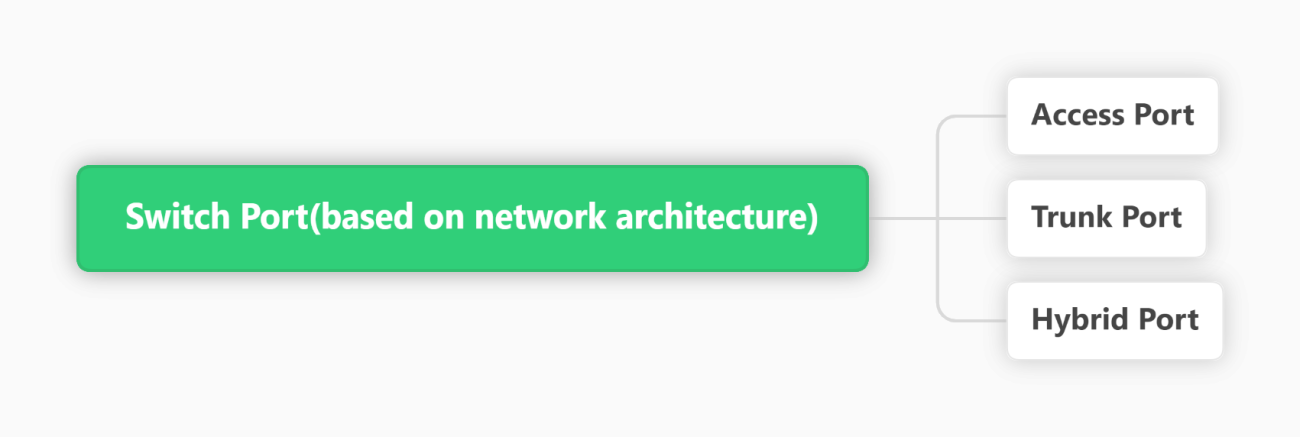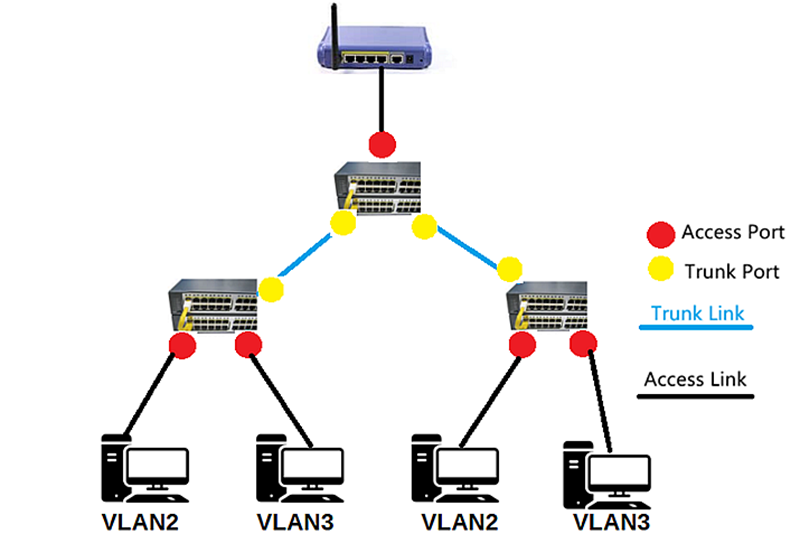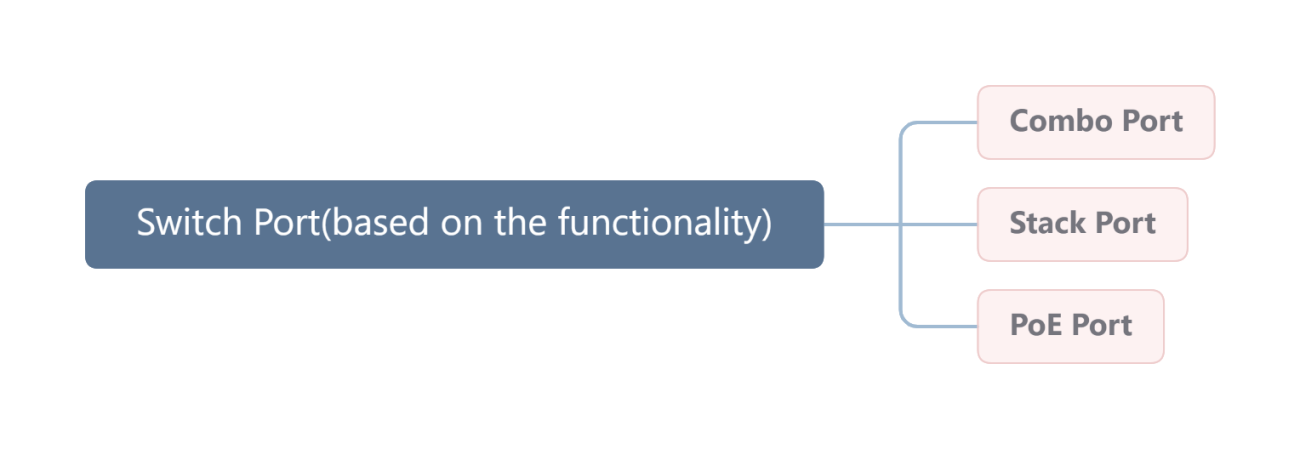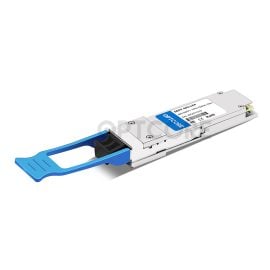Blog, Networking Device
What is a Switch Port? A Complete Guide
A network switch is hardware that allows computers to communicate with each other. It accepts physical connectors from computers and other network devices and then uses packet switching to receive and forward data. In this article, you will learn what a switch port is and how it is categorized. Read to the end to learn all about switch ports.
Table of contents
What is a switch port?
A switch port is a physical switch that evolves with the network and the type of transmission media.
Connecting different devices to a port on a network switch allows them to communicate with each other through data transfer within the switch. Most network devices are also connected to the Internet, allowing them to access it through switch ports.
Switch port types
Switch port types should be divided according to requirements, considering network architecture, speed, and functionality factors.
Based on the network architecture

#1. Access Port
An access port can belong to only one VLAN and is not tagged. Switchport access mode is generally used to connect the switch to host devices.
#2. Trunk Port
A trunk port can be tagged and belong to multiple VLANs. Switchport trunk mode is generally used for inter-switch connections.
#3. Hybrid Port
Hybrid ports can belong to multiple VLANs. Whether the port is tagged or not in the VLAN depends on the specific situation. Hybrid ports can be used for inter-switch connections and connecting users’ computers.
The following figure shows how access and trunk can be used in the same network system.

Based on their functions

#1. Combo Port
Combination ports (and optical multiplexing ports) can support two different physical ports: an electrical port (RJ45 port) and an optical port (SFP port). However, these two different physical ports can not be used at the same time. If you wake up the RJ45 port, the corresponding SFP port will fall asleep.
This port structure provides users with different types of connection options, with powerful features and flexibility to meet special network configuration requirements.
#2. Stacking Port
A stacking port is a unique function port mainly used to connect other stackable Ethernet switches of the same brand, model, and software version.
Among them, multiple stacked switches can be operated together as a unit, and users can realize the management of all switches in the stack through the master switch in the stack. Stacked switches can be added or removed without affecting the stack’s overall performance, making it very flexible and easily scalable.
At the same time, the stacked port capacity is the sum of the ports of all the stacked switches. Stacked ports are used to establish long-distance transmission.
#3. PoE (Power over Ethernet) Port
Power over Ethernet ports (PoE ports) enable data transmission and power over twisted pair cables. They follow different standards and provide different power supplies.
Currently, the ports of Ethernet switches (i.e., PoE switches) following the IEEE 802.3af standard can provide up to 15.4W of power;
The ports of Ethernet switches (i.e., PoE+ switches) following the IEEE 802.3at standard can provide up to 30W of power; and the ports of Ethernet switches (i.e., PoE+ switches) following the IEEE 802.3at-compliant Ethernet switches (i.e., PoE++ switches) can provide up to 90W of power to their ports.
Based on the transmission rate

#1. RJ45 Port
- Registered Jack 45 (RJ45) is an Ethernet-style network port used to interact or communicate with other devices that require an Ethernet network.
- It supports speeds up to 100 Mbps.
- It is used in data centers for server switching, LAN, desktop switch uplinks, etc. 2.
#2. SFP Port
- A Small Form Factor Pluggable (SFP) port is a slot on a network device into which an SFP transceiver can be plugged.
- It supports speeds up to 1 Gbps.
- It enables Gigabit switches to implement long-distance fiber uplinks or short-distance copper uplinks.
#3. SFP+ Port:
- The SFP+ port is an advanced version of the SFP port that supports higher data rates.
- It supports speeds up to 10 Gbps.
- SFP+ transceivers cannot be plugged into an SFP port because SFP+ does not support speeds below 1Gbps.
#4. SFP28 Port
- The SFP28 is an enhanced version of the SFP+ and is designed for 25G signaling.
- It supports speeds up to 25 Gbps.
- It is used for network upgrades.
#5. QSFP+ Port
- The Quad Small Form Factor + (QSFP+) port has 4 channels and supports speeds up to 40 Gbps, four times the speed of its corresponding SFP (SFP+ in this case).
- It supports speeds up to 40 Gbps.
- It has a four-channel 10 Gbps SFP+ interface.
#6. QSFP28 Port
- The Quad Small Form Factor 28 (QSFP28) port has 4 channels and supports 4 times the speed of its corresponding SFP (SFP28 here).
- It supports speeds up to 100 Gbps.
- It has a four-channel 25 Gbps SFP28 interface.
#7. QSFP-DD Port
- Quad Small Form Factor Pluggable Double Density (QSFP-DD) port has 4 channels and supports each channel reaching 50Gb/s by the PAM4 modulation technology
- It supports speeds up to 400 Gbps and 800 Gbps
#8. OSFP Port
- OSFP stands for Octal Small Form-factor Pluggable. OSFP port provides eight 400 Gbps (8x50G or 4x100G) channel electrical interfaces.
- It supports speeds up to 400 Gbps and 800 Gbps.
Different transceivers are plugged into these switch ports; you can see the difference between these corresponding transceivers in our previous article: SFP+, SFP28, QSFP+, QSFP28, QSFP56, QSFP-DD, QSFP112 vs. OSFP, What are the differences?
-
 Cisco SFP-10G-LR Compatible 10GBASE-LR SFP+ 1310nm 10km TransceiverUS$ 12.00 (Excl. VAT)
Cisco SFP-10G-LR Compatible 10GBASE-LR SFP+ 1310nm 10km TransceiverUS$ 12.00 (Excl. VAT) -
 Fortinet FG-TRAN-QSFP28-SR4 Compatible 100GBASE-SR4 QSFP28 850nm 100m TransceiverUS$ 32.90 (Excl. VAT)
Fortinet FG-TRAN-QSFP28-SR4 Compatible 100GBASE-SR4 QSFP28 850nm 100m TransceiverUS$ 32.90 (Excl. VAT) -
 Brocade 25G-SFP28-LR Compatible 25G SFP28 1310nm 10km TransceiverUS$ 27.00 (Excl. VAT)
Brocade 25G-SFP28-LR Compatible 25G SFP28 1310nm 10km TransceiverUS$ 27.00 (Excl. VAT) -
 Moxa SFP-1FEMLC-T Compatible 100BASE-LX SMF 1310nm 20km Industrial SFP TransceiverUS$ 10.00 (Excl. VAT)
Moxa SFP-1FEMLC-T Compatible 100BASE-LX SMF 1310nm 20km Industrial SFP TransceiverUS$ 10.00 (Excl. VAT) -
 Cisco QSFP-40G-LR4 Compatible 40GBASE-LR4 QSFP+ 1310nm 10km TransceiverUS$ 99.00 (Excl. VAT)
Cisco QSFP-40G-LR4 Compatible 40GBASE-LR4 QSFP+ 1310nm 10km TransceiverUS$ 99.00 (Excl. VAT)
Switch port related technologies and mechanisms
Port Security
Switch port security refers to setting security attributes for switch ports to guarantee safe user access.
Switch port security mainly contains three aspects: one is to limit the maximum number of connections on switch ports; the other is to limit the devices connected to switch ports to specified devices (according to the address binding of switch ports); and the third is to detect and carry out specified processing measures when there is a violation event.
Port Aggregation
Port aggregation, also known as EtherChannel (ethernet channel), is mainly used to connect switches. The ports participating in the aggregation must have the exact attributes, such as the same speed, single-duplex mode, trunk mode, trunk encapsulation, and VLAN.
With EtherChannel, the switch combines a group of physical ports as a logical channel, also known as a channel group, so that the switch considers this logical channel a single port. Port aggregation can greatly improve the communication speed of an inter-port link. For example, when two 100Mbp/s ports are used for aggregation, the resulting logical port has a communication speed of 200Mbp/s.
When a link within the EtherChannel fails, the traffic on that link will be automatically transferred to the remaining links, automatically providing redundancy and load balancing.
Port Isolation
Port isolation is a technology that realizes sufficient isolation between client ports to ensure that one client does not receive traffic from another.
Through port isolation technology, users can add the ports that need to be controlled to an isolation group to realize the isolation of Layer 2 data between the ports in the isolation group.
After using the isolation technology, there will be no unicasting, broadcasting, or multicasting between the isolated ports, and viruses will not be spread between the isolated computers. That will increase the network’s security and improve its performance.
Conclusion
Understanding switch port speeds, types, and related technologies is critical to optimizing network performance. This article will help you choose a switch that is better suited for your network.
Read more
- SFP28 vs SFP+ Transceiver, What is the Difference?
- What is SFP Module? An Ultimate Guide (2024)
- 40G QSFP+ vs. 100G QSFP28 Transceiver: Pros and Cons
- What is GBIC Transceiver?
- What is the difference between SFP+, XFP and SFP
- What you need to know about Optcore 400G QSFP-DD DAC Cables
Reference







